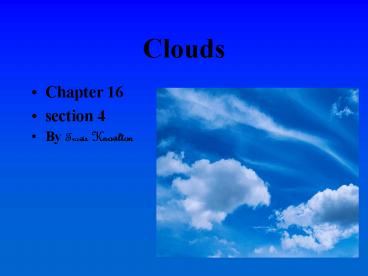Clouds - PowerPoint PPT Presentation
1 / 10
Title:
Clouds
Description:
Cirrus clouds form when water vapor undergoes deposition and forms ice crystals. Cirrus clouds are thin because they form in the higher levels of the atmosphere ... – PowerPoint PPT presentation
Number of Views:45
Avg rating:3.0/5.0
Title: Clouds
1
Clouds
- Chapter 16
- section 4
- By Travis Knowlton
2
Cloud formation
- Clouds are formed through a process beginning
when warm moist air rises. As the air-cools it is
unable to hold the water vapor. Some of the water
vapor condenses around dust particles and forms
tiny water droplets. Clouds are made up of these
droplets.
3
Cirrus clouds
- Cirrus clouds are thin, wispy clouds that usually
form above 18,000 feet. These clouds are blown by
strong westerly winds aloft into streamers known
as "mares' tails" Cirrus clouds generally move
from west to east across the sky and usually
"point" to fair weather. Cirrus clouds form when
water vapor undergoes deposition and forms ice
crystals. Cirrus clouds are thin because they
form in the higher levels of the atmosphere where
little water vapor is present.
4
Cumulus clouds
- Cumulus clouds form as water vapor condenses in
strong, upward air currents above the earth's
surface. These clouds usually have flat bases and
lumpy tops. Cumulus clouds are usually very
isolated with large areas of blue sky in between
the clouds. Most cumulus clouds form below 6,000
feet and are relatively thin and associated with
fair weather.
5
Cumulus (continued)
- However, when the atmosphere becomes unstable and
very strong, upward air currents form, cumulus
clouds can grow into cumulus congests, or
towering cumulus. If the atmosphere is unstable
enough, cumulonimbus clouds, better known as
thunderstorms, form. Cumulus congests and
cumulonimbus clouds can tower from below 6,000
feet to greater than 50,000 feet.
6
Stratus clouds
- Stratus clouds are uniform gray clouds that
usually cover the entire sky. They can form when
very weak, upward vertical air currents lift a
thin layer of air high enough to initiate
condensation. Stratus clouds also form when a
layer of air is cooled from below to its dew
point temperature and water vapor condenses into
liquid droplets. Stratus clouds look like a layer
of fog that never reaches the ground.
7
Stratus (continued)
- In fact, fog that "lifts" off the ground forms a
layer of low stratus clouds. Precipitation rarely
falls from true stratus clouds since the upward
vertical motion needed for precipitation is very
weak, but light mist and drizzle can sometimes
accompany stratus clouds.
8
Vocabulary
- Relative humidity- the percentage of water vapor
in the air compared to the maximum amount the air
can hold - Condensation- the process which a gas, such as
water vapor, changes to a liquid, such as water. - Dew Point- the temperature at which condensation
begins. - Humidity-a measure of the amount of water vapor
In the air
- Measuring relative humidity- measuring relative
humidity van be measured with a psychrometer. A
psychrometer has 2 thermometers, a wet bulb
thermometer and a dry bulb thermometer. The bulb
of the wet bulb has a cloth covering that is
moistened with water. Air is blown over both
thermometers. Because the wet bulb is cooled by
evaporation, its reading drops below that of the
dry bulb.
9
Review
- Local winds are from lakes and global winds are
from tornados an hurricanes. They both come from
water resources. Because one comes from lakes and
ones come from oceans. - The 3 major wind belts are trade winds,
prevailing westerlies, and polar esterlies
- The pilot should go south but probably a couple
miles east also
10
Bibliography
- http//scienceforfamilies.allinfo-about.com
- Text Book
- http//www.usatoday.com
- http//www.usatoday.com/weather/wrelhum.htm































